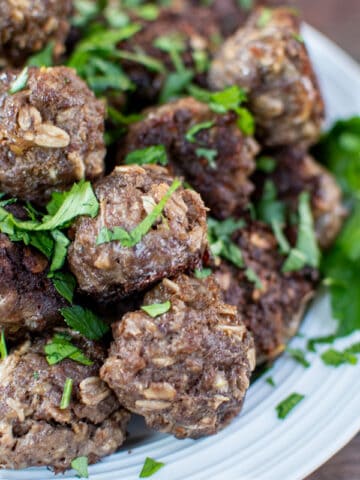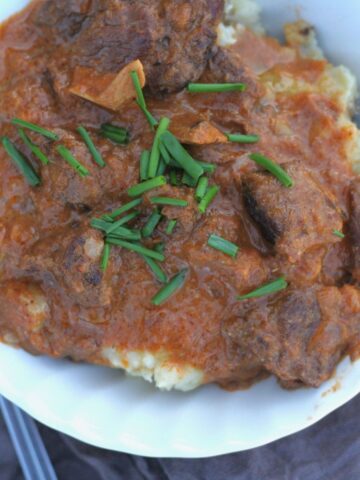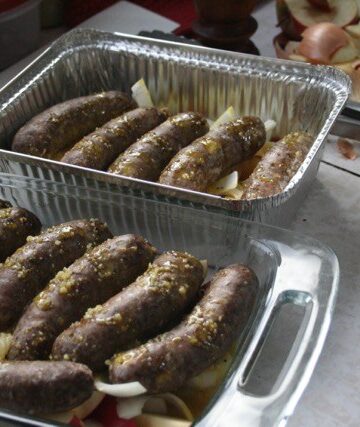A warm stew is the perfect meal after a day of hunting, finishing, or homeschool! Use what ya got to make this delicious, filling Moose Stew with potatoes and kale.

I love to use wild game in my cooking. It's what we can hunt, be it moose, deer, beer, whatever, and I enjoy knowing we use all parts of the animals. I've made a "use what ya got" stew before, but I decided to dial in the ingredients and make this a hearty, rustic version.
Why You Need This Recipe
- Use any meat you have languishing in the freezer, whether it's wild game or beef.
- The veggies don't need to be at their prime since we are cooking them so long. Wrinkly potatoes? No problem!
- You can make this as thick or thin as you want, meaning you can stretch it to feed more people.

Key Ingredients
Stew meat - we've got our moose tag and going hunting this week, so that's my choice for stew, using up the last of the moose in the freezer! Any wild game stew meat chunks will work in this recipe.
Potatoes - any colour, shape, or size here. We are dicing them up so you can easily discard any rough spots. If you have a lot of wrinkly potatoes, I also love using them in twice baked potatoes!
Carrots - pull them from storage or the store, and dice them up. Wash well and you don't even have to peel!
Onions - I grab from the garden and chop the entire thing up, including all the greens. Feel free to use white or yellow and include the greens or not.
Wine - truly, this adds a lot of depth of flavour to the stew and I urge you not to skip it! Of course if you truly don't use any alcohol at all, go ahead and use more broth. But if you have any drinking wine around, add it in. You could also use homemade mead!
How to Make Wild Game Moose Stew
I'll walk you through the Dutch Oven instructions here, but the recipe card includes how to make this in the Instant Pot or Slow Cooker as well!
***See recipe card below for precise measurements and instructions.***
Step 1: Build flavour. Brown the meat if desired, in a heavy bottom Dutch oven. Add the onion to get some colour going.
Step 2: Combine. Add seasonings and liquid, cover, and roast in the oven for a couple hours.
Step 3: Add potatoes. Check that the meat is on its way to tender. Add the carrots and potatoes and return to the oven for another hour or so.

Step 4: Wilt. Make sure the potatoes are soft enough to mash with a fork, then stir in your greens to wilt.

Step 5: Thicken. If desired, thicken with either flour or cornstarch on the stovetop. Serve!
Tips and Tricks
- Make sure and dice your potatoes and carrots evenly so they all cook through at the same time.
- I highly recommend browning your meat for extra flavor. It is definitely an extra step and dirty pot if you are using the slow cooker, but it's worth it.
- Red wine adds a lot of flavour but it's ok to skip it if you need to.
What to Serve with Moose Stew
There's absolutely nothing better than sopping up every last drop of gravy! The best for that is homemade sourdough biscuits, or you might want to up the ante with cheese-topped buns. Focaccia, corn bread, or a classic sourdough boule.

FAQs
When you are cooking with meat in the Instant Pot, never use a quick release. If you immediately release the pressure, you will pull all the moisture out of the meat and make it tough. Instead, I simply set a kitchen or phone timer when I hear the pot signal it is done cooking. 15-20 minutes is perfect and you can safely release the remaining pressure at this time.
This hearty meal feeds a lot of people, but if you are a smaller crew, you can keep leftovers in the fridge for up to 3 days or freeze for longer term storage. I like to freeze in meal size portions so it's ready to go. It's perfect to freeze flat in smaller bags for lunches. Reheat on the stove - it may need a splash of broth to loosen up some. Or you can make a pot pie, use the leftover stew as the filling and this recipe for the crust.
I treat my stew meat as generic red meat. So whatever you have hunted or bartered for, diced up in chunks, will go well here. That includes beef so if you aren't yet into wild game, there's no reason not to enjoy this stew with beef!
More Wild Game Recipes You'll Love
Hey friends, don't forget to follow me over on Instagram, cause if you like me here, I post there a LOT! I'm also on YouTube with tutorials and Facebook for all sorts of things.
If you like this recipe, I’d love if you reviewed it so others can find it easier. Sharing this recipe on Facebook or Pinterest is another way you can help us out at no cost to you. Thanks, xo Kate

Moose Stew
Equipment
Ingredients
- 2 lb moose stew meat can use venison, beef, etc.
- Salt and pepper to taste
- 2 cups chopped onions I used the whole greens too, if you grow your own
- Butter or bacon fat, lard, olive oil, etc.
- 2 teaspoons dried thyme
- 2 teaspoons dried rosemary
- 1 bay leaf
- 2 cups beef broth or water
- ½ cup white or red wine Or use your own mead
- 6-8 cloves garlic, chopped or 3 teaspoon garlic powder
- 2 cups chopped carrots
- 4 cups chopped potatoes
- 2-3 cups rough chopped kale, spinach, or chard can use fresh or frozen
To Thicken
- 2 tablespoons flour or cornstarch
- ¼ cup cool water
Instructions
- Sprinkle your meat with a good dose of salt and pepper. A little heavier than if you were doing it on something you would eat straight as it's going to help season the whole pot.
Instant Pot
- Turn the Instant Pot on to sauté. Add butter and brown the meat in 1-2 batches, depending on the size of your pot, as to not crowd your meat. Add in your onions and saute until they’ve got a bit of colour.
- Add the thyme, rosemary, bay leaf, broth/water, wine, and garlic to the meat and onions. Put the lid on, set to sealing and cook for 30 minutes on high pressure. Natural release for at least 20 minutes before flipping the vent to release remaining pressure.
- Check that your meat is tender. It does not need to be fall apart tender but if it still feels like shoe leather…it should maybe go a bit longer on its own.
- Then add in your carrots and potatoes.
- Cook for another 15 minutes on high pressure and again do a natural release.
- When the time is up, check that your vegetables are fork tender and easily mash if you press a chunk against the side of the pot with a fork.
- Add the kale and stir to wilt.
- We like our gravy thick in our stew, so this next step is optional, but really quite delicious. Omit or use cornstarch to keep it gluten-free.
- Put the flour and water in a canning jar with a lid, shake it up well, then stir it into the stew.
- Turn to saute and cook until desired thickness and serve.
Oven
- Preheat oven to 300°F.
- Put a heavy-bottomed Dutch oven on medium heat. Add butter and brown your meat in 1-2 batches, depending on the size of your pot, as to not crowd your meat. Add in your onions and saute until they’ve got a bit of colour.
- Add the thyme, rosemary, bay leaf, broth/water, wine, and garlic to the meat and onions.
- Cover and slow roast for 2-3 hours.
- Check that your meat is tender. It does not need to be fall apart tender but if it still feels like shoe leather…it should maybe go a bit longer on its own.
- Then add in your carrots and potatoes.
- Replace the cover and cook for another 1 - 1 ½ hours.
- When the time is up, check that your vegetables are fork tender and easily mash if you press a chunk against the side of the pot with a fork.
- Add the kale and stir to wilt.
- We like our gravy thick in our stew, so this next step is optional, but really quite delicious. Omit or use cornstarch to keep it gluten-free.
- Put the flour and water in a canning jar with a lid, shake it up well, then stir it into the stew.
- Cook over medium heat on the stove (careful with the hot handles!) until desired thickness and serve.
Slow Cooker
- Brown the meat in a pot if desired.
- Add the thyme, rosemary, bay leaf, broth/water, wine, onions, and garlic to the meat. Put the lid on and cook on high for 2-3 hours or low for 4-6 hours.
- Check that your meat is tender. It does not need to be fall apart tender but if it still feels like shoe leather…it should maybe go a bit longer on its own.
- Then add in your carrots and potatoes.
- Cook again on high for 2 hours or on low for 3-4 hours.
- When the time is up, check that your vegetables are fork tender and easily mash if you press a chunk against the side of the pot with a fork.
- Add the kale and stir to wilt.
- If you want thicker gravy, I find you can't always make that work in a slow cooker. You can try cornstarch in cold water, then stir that into the stew.
Notes
- Always perform a natural release when pressure cooking meat. This will keep things tender. If you do a quick release, it pulls the liquid out of the meat and it turns tough. 15-20 minutes is good and then you can release the remaining pressure.
- Leftovers keep 3-4 days in the fridge, or freeze for quick meals another day!









Leave a Reply